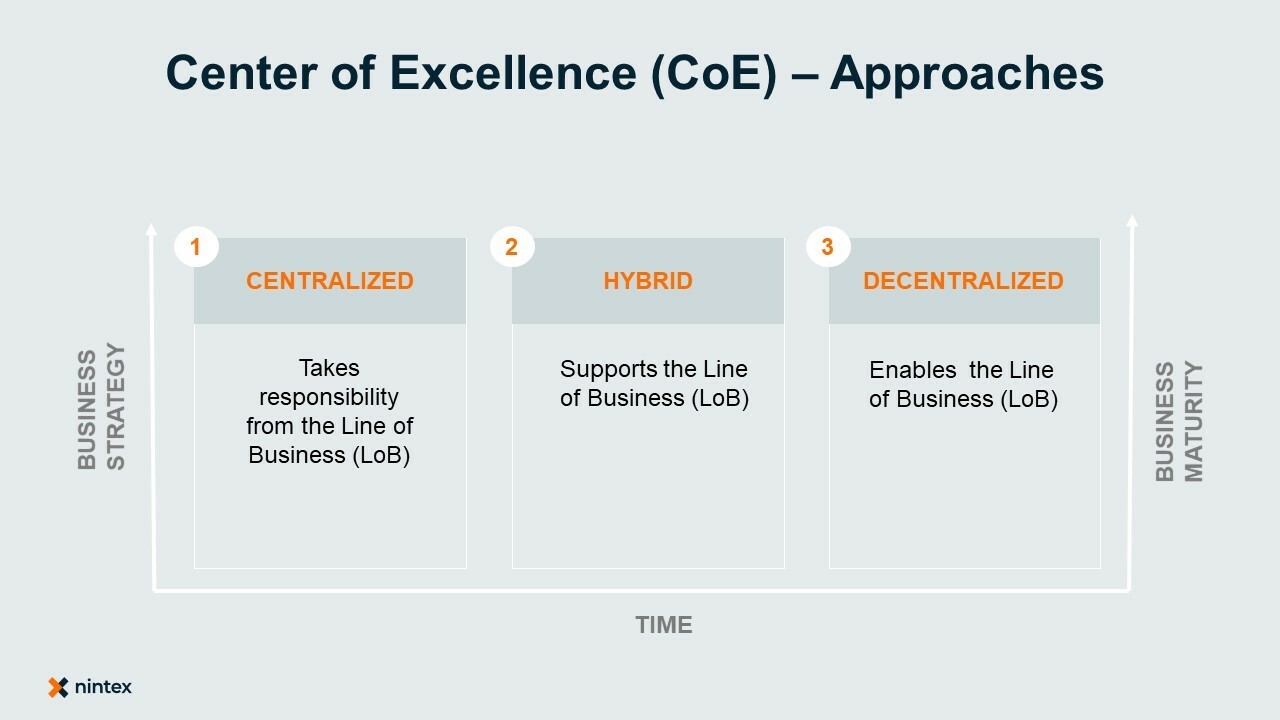What is a Center of Excellence (CoE)?
If you ask 10 people to give you a definition of what a Center of Excellence is, chances are you’ll end up with 11 different answers. Before we dive too deep then, the first thing that I’d like to introduce is how we at Nintex define a CoE:
Comprised of highly skilled people, a CoE’s mission is to develop and deliver best practices within their area of speciality.
To do this, the CoE must develop and maintain a library of reusable standards, methodologies, and artefacts to produce a higher quality of output and boost speed of delivery within the organization.
While this is a good starting point, not all CoEs are the same, rather the roles and responsibilities of the CoE will need to be defined by each organization. So, going one level deeper, here are the three approaches that a CoE might take:

Under a centralized approach the CoE will execute on behalf of the Line of Business (LoB); this might involve running workshops to understand what the as is process looks like, documenting the process in Promapp, reviewing the process with SMEs to identify opportunities for improvement, and building automated solutions where necessary. On the other extreme an organization might adopt a decentralized approach wherein they ask the LoB to perform all of these execution activities themselves, and the CoE simply enables them to do so by building frameworks and providing support. Alternatively, there is a hybrid approach which involves the CoB and LoB sharing the execution activities, with the CoE providing resources and capabilities where needed.
As you might imagine, each approach has its own advantages over the others:
Advantages of a Centralized approach
Ensures that the quality of development is consistent and in accordance with the established standards
- Where individual teams/ BUs are responsible for their own creation, some will create at a higher standard than others. Having a centralized CoE that is responsible for execution will bring consistency and will ensure that minimum standards are achieved.
Accelerates the development of solutions
- Where the LoB is asked to create solutions, they’ll need to do so in between the activities of their day job which can cause delays. A CoE however can provided resources that are 100% focused on development which can result in solutions being built at a much faster pace.
Reduces the time and cost of development through specialization and economies of scale
- Rather than having many novice developers spread across the organization creating solutions, having a team of specialized, experienced developers will allow solutions to be created faster and to a higher standard.
Helps prevent shadow IT
- Where individual teams/ business units are left to create their own solutions, they’ll often leverage multiple tools that do the same thing. Aside from the additional admin overhead (managing multiple systems and vendors) this can also cause problems with people not knowing which system to use for what.
Minimizes the duplication of work through the creation of reusable assets
- A centralized CoE will facilitate the creation of asset repositories such that, where the business makes a request, if a similar solution was previously built for another team it can simply be re-used rather than being built from scratch.
Allows the business to focus on their day job
- When the LoB creates solutions for themselves, they are being taken away from their actual role in the business; centralizing development within a CoE will allow the LoB to focus on the job that they have been employed to perform.
Ability to implement strong governance frameworks
- When an idea goes to a CoE, a governance framework can be established such that the idea progresses through the necessary checks and balances before it is built. This will ensure that all solutions adhere to any internal or external compliances, as well as that technology spend is controlled.
Advantages of a Decentralized approach
Empowers Process Owners and Participants to improve their own processes
- The people who perform the process are often in the best position to suggest improvements, so the improvements that come through will often be more impactful.
Higher adoption from the business for solutions that they build
- Rather than having an external team tell the business ‘this is how you do your job now’, where process improvements come from the LoB itself, they are more likely to be adopted due to the sense of ownership.
Uncovers use cases that would otherwise have not been known
- Where driving process improvement is the responsibility of a central team, often only the major issues, the tip of the iceberg, will be addressed. The LoB however will be able to often uncover use cases that lie beneath the water which, while less obvious, can have significant, cumulative impacts.
More rapid expansion through the business through the elimination of bottlenecks
- Expansion can also be accelerated by allowing the LoB to build solutions themselves as soon as a need arises, rather than having to wait for their idea to reach the top of the CoE’s backlog.
Lower central resource overhead requirements
- The more work that is done by the LoB will translate to a reduction of resources (and therefore cost) required to staff and run a CoE.
With each approach having its own advantages, the question that should be asked is not, ‘what is the best approach', rather ‘what is the best approach for me?’. We believe that you need to align your CoE approach with the maturity of your business and, as your maturity evolves, so should your CoE. This then is the topic for next week’s post where we will explore what business maturity is, how to assess your level of maturity, and how this should influence that approach that your CoE adopts.


